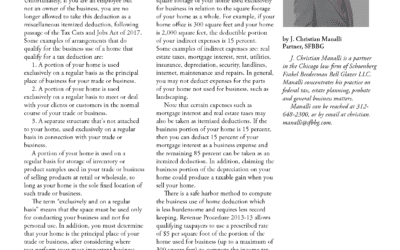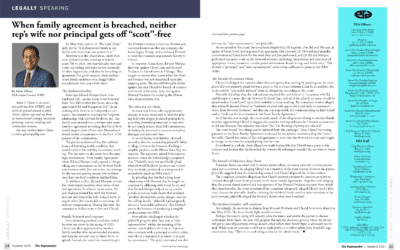I. Statutory Analysis
A. Income Exclusion For Benefits. Gross income does not include amounts received through accident or health insurance (or through an arrangement having the effect of accident or health insurance) for personal injuries or sickness by an employee except to the extent such amounts are attributable to contributions by the employer which were not includable in the gross income of the employee or are paid by the employer (Code Section 104(a)(3))
B. Income Inclusion For Benefits. Amounts received by an employee through accident or health insurance for personal injuries or sickness are includable in gross income to the extent such amounts are attributable to contributions by the employer which were not includable in the gross income of the employee or are paid by the employer (Code Section 105(a))
C. Income Exclusion For Coverage. Gross income of an employee does not include employer-provided coverage under an accident or health plan (Code Section 106(a))
D. Deduction. There shall be allowed as a deduction all the ordinary, necessary expenses paid or incurred during the taxable year in carrying on any trade or business (Code Section 162(a))
E. FICA and FUTA Exclusion. Social Security and Federal unemployment wages do not include the amount of any payment on account of sickness or accident disability or medical or hospitalization expenses in connection with sickness or accident disability made by an employer to or on behalf of an employee after the expiration of six calendar months following the last calendar month in which the employee worked for such employer (Code Section 3121(a)(4), Code Section 3306(b)(4))
F. S Corporation Considerations.
1. With respect to employee fringe benefits, S corporations are treated as partnerships and any 2-percent shareholder of an S corporation is treated as a partner of a partnership (Code Section 1372(a))
2. A 2-percent shareholder is a person who owns or is considered as owning on any day during the tax year more than 2 percent of the stock or voting power of the corporation (Code Section 1372(b))
3. Fringe benefits include amounts paid under accident and health plans and amounts paid by an employer to an accident or health plan
4. For 2-percent shareholders, fringe benefit payments are deductible by the S corporation and taxable as compensation to the recipient employee
5. Accident and health benefits are not subject to FICA or FUTA
II. Tax Treatment of Corporate Distributions, Payments
A. Dividends. Dividends paid by corporations to shareholders are taxable to the recipient shareholders and not deductible to the distributing corporation
B. Compensation. Compensation paid by corporations to employees, including shareholder employees, is deductible by the paying corporation and taxable to the recipient employee
C. Unreasonable Compensation. Excessive or unreasonable salaries paid to stockholder employees can be recharacterized by the IRS as non-deductible dividends which are still taxable to the recipient shareholders
III. Written Plan Requirements
A. Ad hoc payments do not constitute plan (Kaufman v. Commissioner, 35 TC (1961), affirmed 300 F.2d 128 (6th Cir. 1962))
1. Taxpayer was secretary-treasurer of savings and loan association and suffered stroke
2. Successor was elected to taxpayer’s position while taxpayer was appointed executive vice president, a newly created position
3. Taxpayer, upon becoming disabled, continued to receive some salary although his duties were substantially diminished
4. Taxpayer could point to only one other incident where disabled employee received salary continuation payments
5. Court concluded that payments received were ad hoc payments not made pursuant to a plan and did not qualify for then-available disability income exclusion
B. Salary continuation payments may constitute dividends (Chism Ice Cream Company v. Commissioner (21 TCM 25 (1962), affirmed 322 F.2d 956 (9th Cir. 1963))
1. Chism was President and controlling shareholder of Chism Ice Cream Company
2. Chism became physically incapacitated after which his activities on behalf of company were severely curtailed
3. Company continued to pay Chism same or increased amounts of salary during periods of disability
4. Company did not have formal plan of salary or wage continuation for its employees, although it had on occasion continued to pay wages to employees who were temporarily ill or who had surgical operations
5. Court concluded that substantial portions of salary continuation payments to Chism were excessive payments representing non-deductible dividends
6. Court based its decision in part on the fact that the plan had never been reduced to writing, employees were never notified of the existence of the plan and any rights employees might have had were subject to change without their consent
C. General practice of salary continuation payments does not constitute a plan (Lang v. Commissioner, (41 TC 352 (1963))
1. Lang was regional sales manager of Aaron Machinery Co.
2. Upon becoming disabled, Lang continued to receive his normal salary
3. Company had general practice of continuing to pay salaried employees during absences from work, provided absence was for good reason; company did not have published policy and company was not obligated to make salary continuation payments
4. Whether or not salary continuation payments were made were solely within the discretion of company management which took into account the value of an employee’s services to the company and the length of time employed
5. Employees were not notified of company practice of paying salaries to an employee on account of illness.
6. When Lang’s assistant became disabled, company management did not to continue the assistant’s salary during his absence from work until Lang prevailed upon company to do so
7. Court concluded that salary continuation payments to Lang were not made pursuant to a wage continuation plan, Lang’s rights to receive salary continuation payments were not enforceable, there was no notice or knowledge of the plan and the company had not committed itself to certain rules and regulations governing payments pursuant to a definite policy
D. Plan maintained solely for shareholders may not constitute accident or health plan(Larkin v. Commissioner, (48 TC 629 (1967), affirmed 394 F.2d 494 (1st Cir. 1968))
1. All issued stock of company owned equally by Larkins
2. Company adopted resolutions implementing accident and health plan at company’s discretion
3. Other than resolutions, no written plan of any sort existed and the availability of benefits was not communicated to employees until a decision was made to include them
4. Company paid medical expenses for its stockholders
5. Court determined that plan was not maintained for employees, but rather for stockholders, noting that payment of medical benefits was not related to the performance of service by employees of the company
6. In noting the absence of a plan, the court relied on failure of corporate resolutions to describe limits of benefits
E. Medical reimbursement payments to stockholders based on employee status, not stockholder status, deemed made pursuant to a plan (Bogene, Inc. v. Commissioner, (27 TCM 730 (1968))
1. Company made medical reimbursement payments to Bowman, a stockholder of the company, pursuant to resolutions passed at duly convened meetings
2. No written document of any corporate program of medical benefits existed
3. Court concluded that plan existed pursuant to resolutions adopted by company and benefits were not in the nature of ad hoc benefits
4. Court distinguished Larkin because plan fixed benefits and provided that all medical benefits would be reimbursed by company
5. Court noted the absence of a relationship between stockholding and amount of medical benefits being paid, unlike Larkin
6. Court allowed a deduction to Bogene for payments made
F. Employer salary continuation payments for employees are only deductible provided they are made pursuant to a written plan document
1. Plan document requirement can be satisfied by appropriate board of director resolutions setting forth terms and conditions of payments to employees
2. Employee must have notice or knowledge of plan
3. Employer must commit to certain rules and regulations governing payments pursuant to a definite policy
4. Plan maintained strictly for stockholders may not constitute plan for employees
IV. Creating the Plan Document
A. Eligibility
1. Age restrictions
2. Years of service requirement
3. Class or classes of employees eligible to participate
4. Commencement of participation
5. Mechanism for terminating participation
B. Contributions
1. Plan should specify which party is responsible for paying plan benefits and whether or not plan benefits are funded by insurance
2. If benefits partially paid by employees, mechanism should be specified for withholding plan funds from payroll
C. Benefit Provisions
1. Types of benefits provided for participants should be designated
2. Plan should designate whether waiting period exists and duration of waiting period
3. Plan should specify how long benefits will continue
4. If benefits provided for family members of deceased participant, benefit plan should so designate
D. Key Plan Terms Should Be Defined
1. Disability
2. Employee
3. Compensation
4. Participant
5. Claims procedure should be specified (See VI B3 below)
V. Types of Salary Continuation and Disability Plans
A. Unfunded Salary Continuation Plan
1. Employer creates plan obligating itself to continue salary payments to one or more employees upon occurrence of disability
2. Employer receives tax deduction at the time payments are made
3. Employee taxable on receipt of salary continuation payments
4. Payroll taxes imposed on salary continuation benefits for first six months of employee’s absence from work
B. Employer Pays Premiums, Employee Owns Policy
1. Employer pays disability insurance premiums while employee owns disability insurance policy
2. Employer receives tax deduction for premium payments made
3. Employee not taxed on employer’s payment of premiums
4. Employee receives disability benefits directly and is taxed on benefits received
5. Payroll taxes imposed on disability benefits for first six months of employee’s absence from work
C. Employer Pays Premiums and Owns Policy
1. Employer pays disability insurance premiums and remains owner of disability insurance policy
2. Employer does not receive tax deduction for premium payments made
3. Employee not taxed on employer’s payment of premiums
4. Disability insurance benefits received by employer are not taxable
5. Employee is taxed on disability insurance payments received from employer
6. Payroll taxes imposed on disability benefits for first six months of employee’s absence from work
7. Policy payments received by employer are subject to claims of employer’s creditors
D. Employer and Employee Share Premium Payments
1. Premium payments are divided in some fashion between employer and employee while employee owns the policy
2. Employer receives tax deduction for premium payments made by employer
3. Employee not taxed on premium payments made by employer
4. Benefits attributable to employer’s premium payments are taxable to employee while benefits attributable to employee’s premium payments are not taxable to employee
5. Payroll taxes imposed on disability benefits attributable to employer’s premium payments for first six months of employee’s absence from work
E. Employee Pays Premiums Through Salary
1. Employee owns policy and pays all premiums through payroll deduction or otherwise; employer may or may not adjust employee’s salary to cover cost of disability insurance premiums
2. Employee receives disability insurance benefits tax-free
3. Premium is taxable if received by employee as salary
F. Cafeteria Plans
1. Disability insurance benefits may be included in a flexible benefit or cafeteria plan
2. Disability benefits can be paid for by employee either as pre-tax or as after-tax compensation and benefits will be either taxable or non-taxable accordingly
VI. Compliance with ERISA
A. Applicability of ERISA
1. Employee Retirement Income Security Act of 1974 (“ERISA”) imposes numerous requirements applicable to both employee pension benefit plans and employee welfare benefit plans
2. ERISA contains a pre-emption provision which invalidates State laws insofar as they apply to plans governed by ERISA, subject to certain limited exceptions
B. Plan Documentation Requirements
1. Welfare benefit plans under ERISA must be reduced to writing which generally requires a separate written plan although director resolutions may be sufficient
2. Plan documents should specify employees eligible to participate, level of benefit coverage, procedures for receiving plan benefits and other salient features of the arrangement
3. ERISA plans are required to contain a claims procedure pursuant to which plan participants are advised of their available options for pursuing the payment of benefit claims
4. Plan document must identify the fiduciary responsible for the operation and administration of the plan
5. ERISA plans are usually freely amendable, although amendments on a retroactive basis may be limited
C. Reporting and Disclosure Requirements
1. Annual report (e.g. Form 5500) generally must be filed for welfare plans within seven months after the end of each plan year
2. Summary annual report must be furnished to each participant within nine months after the end of each plan year containing relevant information regarding the plan’s financial status
3. A summary plan description must be distributed to participants within 90 days after becoming eligible to participate or within 120 days after the establishment of the plan
4. Certain types of plans are exempted from many of the reporting and disclosure requirements of ERISA
a. Plans having fewer than 100 participants at the beginning of a plan year are not required to file an annual report and are exempted from distributing summary annual reports for the plan year
b. Exemption only applies if the plan is unfunded or funded through insurance paid by employer and/or employee contributions.
D. Fiduciary Standards
1. Transactions between plan fiduciaries and so-called “parties-in-interest” are prohibited and could result in substantial penalties under ERISA
2. Fiduciaries who handle assets of certain plans are generally required to be covered by a fidelity bond
3. ERISA imposes certain fiduciary duties on so-called fiduciaries or persons who handle and administer plan assets



